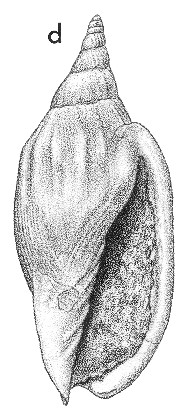
Revised descriptions of New Zealand Cenozoic Mollusca from Beu and Maxwell (1990)

 | Revised descriptions of New Zealand Cenozoic Mollusca from Beu and Maxwell (1990) | 
|
  (Pl. 49d): "holotype" of Alcithoe swainsoni Marwick, GS1163, R22/f6498, Kai-Iwi Beach, west of Castlecliff, Wanganui (Kaimatira Pumice Sand ?), Castlecliffian (TM6841, GNS) |
Beu & Maxwell (1990): Chapter 16; p. 366; pl. 49 d.
Synonymy: Voluta arabica Gmelin 1791, p. 3461; Voluta elongata Swainson 1821, pl. 20, 21 (not of Lightfoot, 1786, nor of Schröter, 1804); Voluta pacifica Perry 1810, in 1810-11, pl. 30; Fulgoraria depressa Suter 1908b, p. 182; Fulgoraria turrita var. nukumaruensis Marshall & Murdoch 1920, p. 133; Alcithoe lutea Marwick 1924c, p. 200; Alcithoe swainsoni Marwick 1926a, p. 294 (new name for Voluta elongata Swainson, preoccupied); Alcithoe detrita Marwick 1926a, p. 289; Alcithoe transformis Marwick 1926a, p. 293; Alcithoe acuta Marwick 1926a, p. 295; Alcithoe swainsoni motutaraensis Powell 1928a, p. 361; Alcithoe (Alcithoe) arabica, Beu & Maxwell 1990, p. 366, pl. 49d.
Type species of Alcithoe H. & A. Adams, 1853
Classification: Volutidae: Zidoninae
Description: Large for family (80-180 mm high), with very long, only weakly tapered last whorl, moderately tall to short, conic or weakly stepped spire, and long, narrow aperture. Sculpture highly variable, smooth or with a single spiral row of nodules, nodules small to large and pointed. Outer lip reflected and strongly thickened in adults, but thin and sharp in immature specimens; inner lip a wide, thin glaze, except for a wide, flat collar extending over neck from lower part of columella of most adult specimens; bearing 4 to 6 prominent, narrow plaits low on columella. Anterior siphonal notch wide and shallow; fasciole very low, flat to weakly convex, with much more prominent axial ridges than on remainder of teleoconch surface; margined by a low ridge. Protoconch large, dome-shaped or subcylindrical, 4-5 mm wide.
Comparison: Alcithoe arabica has direct development; a small crawling animal with a shell consisting of the protoconch plus an initial quarter-whorl of the teleoconch hatches from the large (about one cm in diameter), solitary, white, opaque, almost spherical, calcareous egg case. Consequently, there are marked differences between populations around the country at present, and there are some reasonably consistent differences according to ecological station — e.g., the long-spined form regarded by many earlier authors as "typical" A. arabica is limited to estuarine environments. Large collections from many localities (e.g., in NMNZ) show that the many named forms are part of one species varying greatly in nodule prominence and spire height, as well as in colour pattern; less variable characters such as protoconch size, the presence of a wide columellar collar in most shallow-water specimens of A. arabica, and the depth and width of the anterior siphonal notch are the only ones useful for separating species. So, although there actually are several species of large Alcithoe living around New Zealand, there is only one common shallow-water species, Alcithoe arabica. The many named forms included in our synonymy that were based on Nukumaruan or Castlecliffian fossils are in our opinion also part of the variation of A. arabica; they show the same range of variation as modern shells.
The status of Marwick's "holotype"(?) of Alcithoe swainsoni is in doubt as, when he selected it, Marwick was actually renaming the preoccupied Voluta elongata Swainson. Strictly speaking, the holotype is the specimen Swainson used to base his species upon, and Marwick's specimen has no status in nomenclature.
Distribution: Nukumaruan-Recent. Recent, New Zealand (types of Voluta arabica, Voluta elongata, Voluta pacifica, Fulgoraria depressa, and Alcithoe swainsoni motutaraensis); Nukumaru Brown Sand, Nukumaru Beach, west of Wanganui, Nukumaruan (types of Fulgoraria turrita var. nukumaruensis and Alcithoe detrita); Castlecliff, Wanganui, Castlecliffian (types of A. swainsoni, A. transformis, and A. acuta); Okauawa Stream, Kereru Road, central Hawke's Bay, Nukumaruan (type of Alcithoe lutea Marwick, a secondary homonym of Voluta lutea Watson, 1882, placed in Alcithoe by Dell (1978)). The widespread and abundant large volute of New Zealand shallow-water faunules (estuarine mud-flats to middle shelf) and of many different ecological situations in the fossil record, throughout Wanganui, Hawke's Bay, Wairarapa and North Canterbury.
Cite this publication as: "A.G. Beu and J.I. Raine (2009). Revised
descriptions of New Zealand Cenozoic Mollusca from Beu and Maxwell (1990). GNS
Science miscellaneous series no. 27."
© GNS Science, 2009
ISBN
978-0-478-19705-1
ISSN 1177-2441
(Included with a PDF facsimile file
copy of New Zealand Geological Survey Paleontological Bulletin 58 in CD version
from: Publications Officer, GNS Science, P.O. Box 30368 Lower Hutt, New
Zealand)